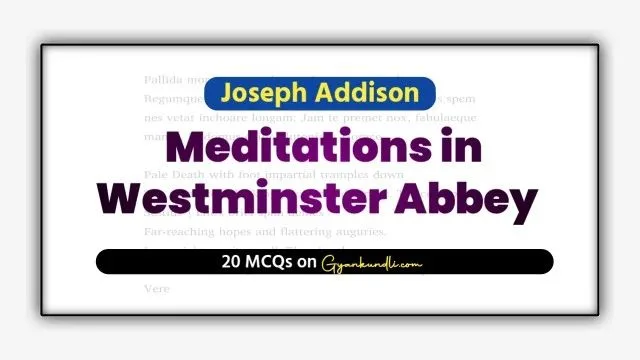When to the Sessions of Sweet Silent Thought MCQ Quiz : William Shakespeare (1564–1616) was the greatest dramatist and poet of the English Renaissance. He wrote 154 sonnets and many plays that explore human emotions, love, time, and beauty. His sonnets are written in his own English or Shakespearean form.
Introduction to Sonnet 30
Sonnet 30, titled “When to the Sessions of Sweet Silent Thought”, is one of Shakespeare’s most famous sonnets. It belongs to the Fair Youth sequence, where the poet expresses deep feelings of friendship and love toward a young man. The sonnet was first published in 1609. It reflects on memory, loss, and consolation. The poem presents the poet as a man who recalls his past sorrows and regrets but finds comfort in the thought of his dear friend.
Text of Sonnet 30
When to the sessions of sweet silent thoughtI summon up remembrance of things past,I sigh the lack of many a thing I sought,And with old woes new wail my dear time’s waste:Then can I drown an eye, unus’d to flow,For precious friends hid in death’s dateless night,And weep afresh love’s long since cancell’d woe,And moan th’ expense of many a vanish’d sight;Then can I grieve at grievances foregone,And heavily from woe to woe tell o’erThe sad account of fore-bemoaned moan,Which I new pay as if not paid before.But if the while I think on thee, dear friend,All losses are restor’d, and sorrows end.
Summary of the Sonnet 30
The poem begins with the poet sitting in silence, thinking about his past. These “sessions of sweet silent thought” are like mental court sessions where he judges his own life. He remembers many old losses—friends who are dead, missed opportunities, and wasted time. He mourns them again, as if he is paying fresh tears for old griefs. The poet regrets the things he could not achieve and the people he has lost. But in the end, he finds joy when he remembers his dear friend. That sweet memory cancels all his sorrows and makes him feel rich again.
Themes
-
Memory and Time: The poet looks back at the past and reflects on the pain of remembrance.
-
Loss and Regret: He mourns lost friends and missed chances.
-
Love and Consolation: The thought of a beloved friend heals his sadness and restores his happiness.
-
Power of Friendship: True friendship has the power to comfort the heart and overcome grief.
Form, Meter, and Rhyme Scheme of Sonnet 30
-
Form: Shakespearean Sonnet (also known as English Sonnet).
-
Structure: 14 lines divided into three quatrains and one rhymed couplet.
-
Meter: Iambic Pentameter – each line has ten syllables, with an unstressed syllable followed by a stressed one (da-DUM da-DUM da-DUM da-DUM da-DUM).
-
Rhyme Scheme: ABAB CDCD EFEF GG.
When to the Sessions of Sweet Silent Thought MCQ Quiz
Discover more from Gyankundli
Subscribe to get the latest posts sent to your email.

















👌👌
Thank you 😊